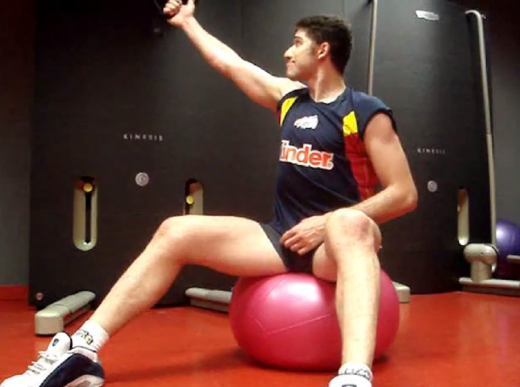
Kabat with Kinesis
Some principles of this technique are applicable to the physical tasks that we carry out at the sport hall or gym. It has become an essential exercise within the functional training and injury prevention programs.
Kabat’s diagonals, more specifically, our adaptation for shoulder of volleyball players will facilitate selective muscles contractions and target movements.
Muscular sequential activation of a spiral movement will induce the participation of the weak muscles at their fullest potential, being assisted, but not replaced by others muscles involved. Furthermore, positive effects on eccentric contraction strength will be achieved.
The method consists of 2 diagonal (D1 and D2) patterns of movements. Diagonals at shoulder joint comprise flexion/extension, abduction/adduction and external/internal rotation movements. Shoulder movements are combined with scapula, elbow, forearm, wrist and even fingers motion.
From/to To/from
D1 Extension-Abduction-Internal rotation Flexion-Adduction-External rotation
D2 Flexion-Abduction-External rotation Extension-Adduction-Internal rotation
Volleyball’s actions are not analytical, consequently it is recommended to implement exercises of functional training. We are doing it with functional diagonal pattern for the shoulder, also acting to other joints of upper extremity. To sum up, it’s a really comprehensive exercise.
DO IT and BE CREATIVE:
Adapt it to the training facilities at your disposal, cable weight system, dumbbells or elastic resistance bands, perform it during warming-up, injuries prevention programs or as a part of weight training workouts in the gym. And combine it with core training or perturbation activities.
TIPS:
– The starting position implies stretch of the muscles that will contract.
– Make the movement against resistance of the elastic band or weight with a medium speed. It’s important for your tendinous insertion, to perform a slow way back movement (eccentric phase).
– Keep looking at your hand movement, easing the movement and increasing the beneficial effect of this method.
– Between 2 to 5 sets. 2 it could be an indication for warm up and 5 would be for a rehabilitation program task.
– From 10 to 15 repetitions, with a load that leads to finish each set with a relative difficulty.
– If you are a beginner on weight training, probably you may be comfortable working with 5 kg. of resistance during the first 4 weeks and then you may consider shift to 10 kg. with a proper technique execution. If you have a high level of strength but never practice with the diagonal patterns, it is suggested to initiate with 15 kg., after which, you may increase the load when sets of 15 repetitions, are executed correctly and full control of movement are light.
– Do work with both arms although you have problem located in only one.
Muscle weakness, muscle imbalance, rehabilitation after surgical treatment, shoulder tendon injuries, shoulder impingement or subacromial syndrome… using Kabat diagonal patterns of movements will definitely benefit all of the conditions mentioned above, and certainly, differences of each case must be taken into consideration as well.
For experts: the third diagonal showed is performed with a light variation (author’s election) from the original technique.
For similar articles, read Physiotherapy.
To read more news click on Latest news.
Share your thoughts about this on WoVForum.
0 comment
Exelent exercises! Thank you also for the video